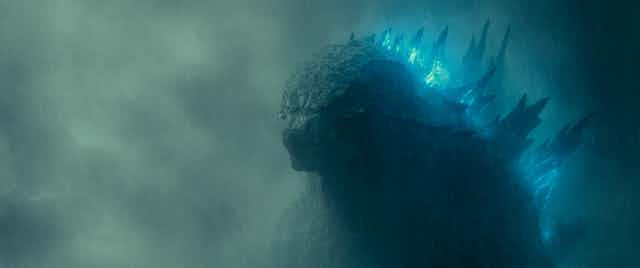How do you get rid of a giant pest like Godzilla, King Kong, or any of the other assorted kaiju (Japanese for “strange beast”)? Evidence from films suggests that these monsters are highly destructive and tremendously difficult to kill.
To a mathematician, however, this situation is nothing more than a predator-prey interaction problem. By accurately simulating the properties of the species we want to eradicate, we can predict the required properties of the predators we would need to create. If we look to the movies that made them famous, we find two alternative strategies for dealing with an invasion of multiple monsters. We could build our own mechanical monsters, or create a kaiju of our own.
Option one: deploy jaegers
Giant offensive robots, known as jaegers (“hunter” in German) have the advantage of being completely under our control. In reality mass production of such weapons appears to be out of the question – not least because, as seen in Pacific Rim, they are also often giant nuclear reactors on legs, prohibitively expensive and difficult to engineer. But, assuming we solved these issues (and that secretive organisations had them ready when needed), jaegers are still only a viable solution if they are far deadlier than the kaijus.
Jaegers are typically dispatched alone to specific areas (for example, Manila, Hong Kong, Los Angeles and other locations around the pacific rim) so each mechanical fighter must be able to get rid of multiple creatures before falling. But given the small number of jaegers that the world would be able to produce which could stand up to the onslaught, we would only be able to defend a country little bigger than the UK using jaegers. So, unless we want to move the world’s population onto a few islands we need a more radical idea to defend the larger continents.

Option two: create a kaiju
In the words of fictional scientist Ishiro Serizawa (most recently seen in Godzilla: King of the Monsters), we could allow nature to take its course and “let them fight”. Kaijus naturally prey on each other so we could genetically modify an animal to grow to a monstrous size (a good blast of radiation seems to help them grow in no time at all) and predate on them, as seen in numerous entries in the Godzilla canon.
Now, this may seem crazy. As soon as we release our own mutants we are unable to control them and, if Jurassic World tells us anything, it’s that even a highly trained predator has no master. So apart from the additional collateral damage that this would entail, we may be generating a bigger problem for ourselves by creating this new top predator species.
History is littered with failed examples of ad hoc eradication that have gone drastically wrong. Cane toads were introduced into Australia to eat beetle pests. Unfortunately, for several reasons, including having no natural predators, the toad population grew dramatically, and they became the pest. But this tactic can work if approached scientifically. There are successful examples of biological eradication through the introduction of natural predators. California’s citrus industry was saved from the cottony cushion scale by the careful introduction of the cardinal ladybird from Australia, for example.
Critically, the biggest benefit of allowing kaijus to control their own populations is that once we have generated the initial species, the monsters will naturally keep themselves in check. So, as long as we learn from past mistakes and carefully choose our predator’s properties, we need not worry about costs of managing the monsters.
To fight a fictional kaiju, the creature would have to be extremely fast, tough (but not aggressive to humans), and have a short life expectancy (so they die out when not needed). Unfortunately, even with such features, our simulations suggest that such predators would be unable to wipe the kaiju out completely. Instead the predator and prey would find a sustainable balance. Indeed, the best we can manage is to increase the speed of our monsters, meaning that they would be able to cover larger hunting grounds, and reduce the number of enemy kaiju.

Based on the above mathematical predictions, and considering the catalogue of creatures seen throughout kaiju movies, the best option would appear to be genetically modifying a species of moth to create a creature like Mothra. Indeed, she has won fights against Godzilla several times. Specifically, she is extremely fast (reaching at least Mach 3), friendly to humans and, generally, a new Mothra is born only when one is killed (providing the population control).
Overall, mathematical modelling from these fictional parameters suggests that jaegers are the best strategy for small islands, while genetically modified kaiju work best to protect larger land masses. As a final point we note that Japan’s land area is very close to the cut-off size that determines if jaegers will be a successful strategy. This may underlie the reason why Japan is a world-renowned creator of kaiju movies. They act as simulations, like our mathematical model, predicting the outcomes of the ensuing battles. So, because of Japan’s uncertain fate, they produce films alternating between using monsters and jaegers to protect humans, to ascertain which solution is more successful.
However, both of our main strategies rely on the same idea: create a monster to catch a monster. So we leave with a final word of caution – as philosopher Friedrich Nietzsche wrote: “He who fights with monsters should be careful lest he thereby become a monster.”

